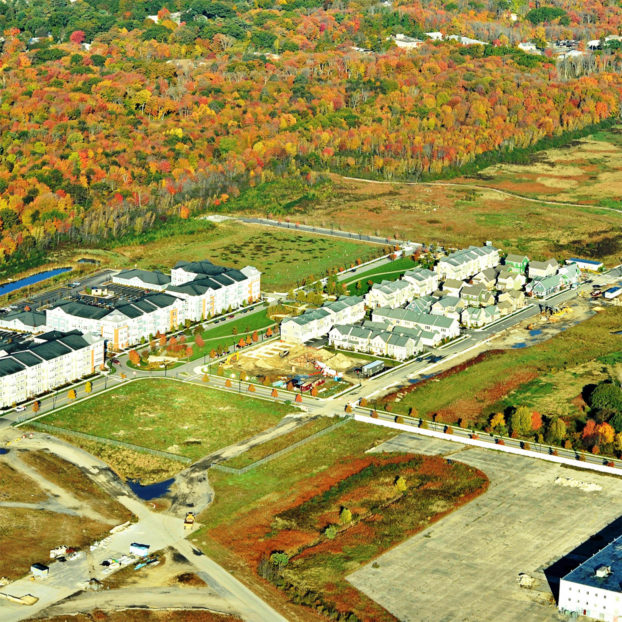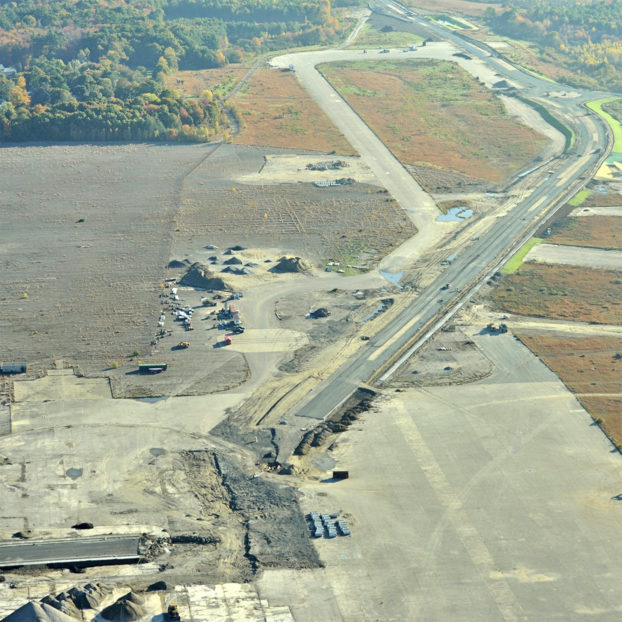Once an operational airfield utilized during World War II, the former Naval Air Station in South Weymouth has been inactive since 1997. At over 1,400 acres in size, this property, bordering the communities of Weymouth, Abington, and Rockland, offers a unique opportunity to provide housing and commercial space a short distance from the City of Boston.
Due to its status as a Superfund site, large scale redevelopment efforts of this area were started by LNR Property Corporation in 2007. EP was selected by LNR to engage in this project, assisting with civil, geotechnical, environmental, and wastewater engineering services, specifically providing civil site engineering, environmental cleanup, wastewater engineering, Contractor procurement, and construction oversight for this large private redevelopment project.
This large scale, multi-phased project began with Phase 1 where EP supported the construction of 35,000 linear feet of utilities, subgrade preparation for 500 units of housing, roadway construction, and connection to the Town of Weymouth’s water and sewer systems. When completed, the project, managed by Tishman Construction on behalf of LNR, is expected to consist of 2,500 units of housing, 400,000 square feet of commercial/retail development, and a new 18-hole golf course.
Civil/Site work focused on assessing existing conditions and development constraints associated with soil conditions in the vicinity of Phase 1; conducting an independent review of a proposed 1 MGPD wastewater treatment system needed for subsequent phases of development; evaluating alternative water supply sources; and assisting with the design of 8.5 miles of water main to the Site from an MWRA connection in Quincy. The design for an advanced on-site membrane bioreactor treatment plant includes onsite disposal beds and a groundwater discharge to French’s Stream.
EP assisted LNR in analyzing a variety of foundation related options for addressing the subsurface conditions for Phase 1 and the most efficient Conceptual Layout, given the project constraints. Foundation options included the surcharging of organic materials; soil excavation and backfilling; installation of geopiers and helical piles; in-situ ground improvements; and a variety of combined options. EP’s analysis included detailed assessment of soil characteristics (including potential settlements); soil quantity estimates using AutoCAD 2007 and Civil 3D software; assisting with a variety of conceptual layouts; and cost estimating. The final approach was to mine all the unsuitable materials and replace it with suitable fill. Approximately 215,000 cubic yards of unsuitable soils (peat, organic silt, soft silt and clay) were removed from the site and replaced with suitable fill. Activities commenced in the Winter of 2007 and were completed in March, 2008.
As a first step in this process, EP reviewed the previous consultant’s preliminary design and coordinated key meetings with the MADEP during the preparation of the Final Environmental Impact Report (FEIR) to determine their disposition on the proposed design. EP also performed an independent review of an extensive finite element groundwater model. Complex modeling is necessary to demonstrate that the estimated wastewater treatment facility discharge of approximately 1.5 mgd over 10 acres of disposal beds will not create mounding and breakout.
Site preparation activities included the demolition of a large paved and concrete slab area, as well as demolition of seven existing structures along the main access road. Preparation activities also included general grading to increase the grade across the site by 2 to 5 feet, and excavation of large quantities of peat and organic silt materials and replacement with suitable backfill. EP provided fulltime construction oversight for construction of utilities including, two large detention ponds, and installation of sewer utility structures at the site. While redevelopment efforts for a site this large and complex are neither easy nor quick, construction of utilities is a vital step and one that is necessary for full-scale redevelopment efforts to be realized.




